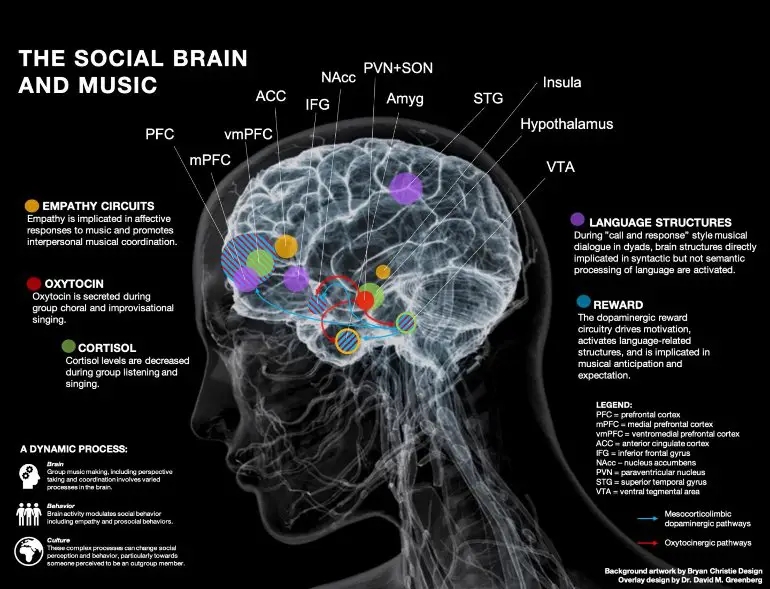A team of social neuroscientists from Bar-Ilan University and the University of Chicago developed a model of the brain that focuses on what happens when people make music together. They concluded that music making didn’t evolve as mere entertainment, but is a core feature of human existence with important social implications. This backs up studies that have explored pro-social behaviour in children making music together.
The team included Dr. David Greenberg, a social neuroscientist, professional musician, and Zuckerman Postdoctoral Scholar at Bar-Ilan University in Israel; Dr. Ilanit Gordon, an Associate Professor at the Department of Psychology and Director of the Social Neuroscience Lab at the Gonda (Goldschmied) Multidisciplinary Brain Research Center at Bar-Ilan; Jean Decety, the Irving B. Harris Distinguished Service Professor in Psychology and Psychiatry, and director of Child Neurosuite at the University of Chicago.
They explored the latest advances in social neuroscience and the field of music, including evolutionary theory. They synthesized these into five key functions and mechanisms of the brain that contribute to social connection through music:
1. empathy circuits – which help us appreciate how other people are thinking and feeling and can be improved through group music making
2. oxytocin secretion – the ‘love hormone’ which contributed to our feelings of social bonding and connection. This is secreted when people sing together.
3. reward and motivation, including dopamine release – dopamine produces a feeling of pleasure and is released during musical anticipation, and aids our sense of reward and motivation
4. language structures – these are involved in back-and-forth musical dialogue (‘call and response’)
5. cortisol – contributes to stress but is decreased when people sing together or listen to music together in groups
They found that the social brain networks that are used in making music overlap with the networks in the brain that are used in socialising. They concluded that music is a powerful tool that can bring individuals together, promote empathy and communication, and heal social divisions.

Alt text: the image of the brain developed by Dr David Greenberg et al. Includes 12 blobs of colour pointing to brain regions used in group singing. Has captions giving more detail around the five functions and mechanisms. Background artwork: Bryan Christie Design Overlay design: Dr. David M. Greenberg
SOURCES:
Original research: The Social Neuroscience of Music: Understanding the Social Brain Through Human Song – The American Psychologist
Neuroscience News: “What Happens in the Brain When People Make Music Together?”
Psychology Today: “What Happens in the Brain When We Make Music Together | Psychology Today”
Medical Express: “What happens in the brain when people make music together?”
| BENEFIT: | PRO-SOCIAL BEHAVIOUR, SOCIAL CONNECTION, BONDING |
| TARGET GROUP: | ALL |
| AGE: | ALL |
| MUSIC TYPE: | GROUP SINGING |
| TYPE OF STUDY: | ACADEMIC RESEARCH: RESEARCH SYNTHESIS |
| NOs INVOLVED: | / |
| PERIOD OF STUDY: | / |
| DATE: | 2021 |
| PLACE: | ISRAEL & CHICAGO |

I trust in this frequency idea !
mercibeaucouptv.com
LikeLike